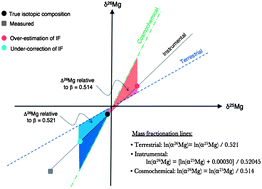The possibility of establishing an accurate relative chronology of the early solar system events based on the decay of short-lived 26Al to 26Mg (half-life of 0.72 Myr) depends on the level of homogeneity (or heterogeneity) of 26Al and Mg isotopes. However, this level is difficult to constrain precisely because of the very high precision needed for the determination of isotopic ratios, typically of ±5 ppm. In this study, we report for the first time a detailed analytical protocol developed for high precision in situ Mg isotopic measurements (25Mg/24Mg and 26Mg/24Mg ratios, as well as 26Mg excess) by MC-SIMS. As the data reduction process is critical for both accuracy and precision of the final isotopic results, factors such as the Faraday cup (FC) background drift and matrix effects on instrumental fractionation have been investigated. Indeed these instrumental effects impacting the measured Mg-isotope ratios can be as large or larger than the variations we are looking for to constrain the initial distribution of 26Al and Mg isotopes in the early solar system. Our results show that they definitely are limiting factors regarding the precision of Mg isotopic compositions, and that an under- or over-correction of both FC background instabilities and instrumental isotopic fractionation leads to important bias on δ25Mg, δ26Mg and Δ26Mg values (for example, olivines not corrected for FC background drifts display Δ26Mg values that can differ by as much as 10 ppm from the truly corrected value). The new data reduction process described here can then be applied to meteoritic samples (components of chondritic meteorites for instance) to accurately establish their relative chronology of formation.

You have access to this article
 Please wait while we load your content...
Something went wrong. Try again?
Please wait while we load your content...
Something went wrong. Try again?


 Please wait while we load your content...
Please wait while we load your content...